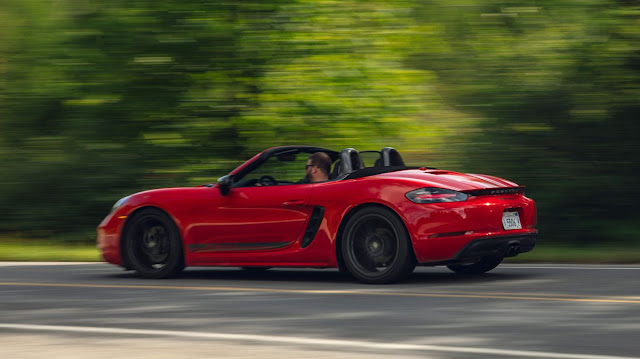Tested: The 2024 Subaru Impreza Is a Clif Bar on Wheels
Coming to a trailhead parking lot near you, the new Impreza—the 182-hp RS version, at least—gets there quicker than ever.
9/14/23 UPDATE: This review has been updated with instrumented test results for the Impreza RS.
"Would you like to come over for dinner tonight? We're having two backpacks full of nutritional granola bars," said no one ever. Though pressed with enough soy protein to grow hair on your legs, those individually wrapped caloric boosters are a matter of convenience rather than taste. They call to mind the new Subaru Impreza. It's not as exciting to drive as the BRZ or the WRX, but like a Clif Bar, the Impreza uses only the necessary ingredients, and its handy size and affordable price make preparing for life's real adventures a lot easier.
Although still basic, the sixth-generation Impreza has gotten a bit tastier with bigger screens, a more powerful engine option, and a wider array of standard features. Some things, though, have been lost. After checking the books, Subaru decided to stop offering a four-door sedan and the manual transmission, in favor of making what 73 percent of its Impreza customers were buying: hatchbacks with CVTs.
Design-wise, the new Impreza seems to be doing a Mazda 3 impression, but this car has always been about driving to go do something cool rather than about looking cool. And so the new design didn't change the dimensions of Subaru's smallest all-wheel-drive car: It has the same wheelbase, length, and ground clearance as the previous generation, but is a little taller and heavier. The big functional change is hidden: Subaru has integrated a plastic step into the rear door sills—a big help when you're loading your lifestyle gear onto the roof—and the rear doors are designed to accommodate your hips while you're up there tying everything tight.
The updated body structure is a claimed 10 percent stiffer torsionally, as Subaru engineers weren't shy with the structural glue this time around. The difference could be felt when we were pretending to be Colin McRae driving the paved twisties in Paso Robles, California. The extra support and sound deadening have made the Impreza heavier but easier on the ears. Even on the highways that stretch between the casks of cabernet sauvignon in wine country, this Subaru was pleasantly quiet to drive. Even across the tattered pavement around our Michigan headquarters, the Impreza has a fine ride.
While parts of the new Impreza got tougher, others have relaxed. A newer dual-pinion electric power steering rack, similar to what's used in the WRX, has lightened the steering effort. The Impreza also switched to an electronic brake booster, which has resulted in a lighter pedal effort. The brake-based torque vectoring, previously only offered on more expensive Imprezas, is now standard across the updated three-trim lineup.
That lineup consists of the base Impreza, the Sport, and the RS, which returns as the top performance model. In place of the standard 2.0-liter engine, the RS uses a 182-hp 2.5-liter flat-four from the Crosstrek and an updated CVT. The 7.8 seconds it takes to get to 60 mph is a 1.2-second improvement over the previous 2.0-liter Impreza we tested. That's significant on paper but the performance improvement is less transformative than it sounds. The 3.0 seconds to 30 mph is mid-1990s Toyota Tacoma energy. While the Impreza remains a marginally quicker accelerator than the heavier Crosstrek, it’s still a poky little thing, especially when stepping out to pass. The Impreza took 6.0 seconds to climb from 50 to 70 mph. Still, it's a much-welcome advantage over the base engine, which in our last test took 9.0 seconds to reach 60 mph. We're thankful the RS is far quicker than that, but so are most cars.
There are paddle shifters behind the steering wheel, and the CVT tries its best to imitate an eight-speed automatic, but we're still disappointed the RS forgoes the option of a manual transmission.
Despite the bigger engine's 30-hp and 33-lb-ft advantage over the 2.0-liter base unit, the more powerful engine can't match the enthusiasm of the updated chassis. When you toss the RS into downhill hairpins hard enough to make the all-season Yokohama Avid S34P tires cry out, the delightful chassis carries speed without a hiccup. On the skidpad, the Impreza RS delivered 0.83 g of grip.
The new Impreza gets a larger fuel tank: 16.6 gallons, up from the previous car's 13.2. However, fuel economy has dipped marginally. When comparing base hatchbacks, the EPA estimates the new Impreza gets 27 mpg city and 34 mpg highway, down from 28 and 36 mpg previously. The new RS trim is 1 mpg behind at 26 and 33 mpg, respectively, but it beat its EPA highway rating by a full 4 mpg on our 75-mph highway fuel-economy test.
The RS gets dark gray 18-inch wheels, a black front grille, side skirts, heated mirrors, and adaptive LED headlights that peek around corners as you drive. Sport and RS models offer a new exclusive color, Oasis Blue Pearl, that's reminiscent of the limited-edition 2016 WRX STI and BRZ Series.HyperBlue. RS badges, illustrated with two opposing horizontal pistons à la the boxer-engine setup, are fitted inside and out.
The changes most people will notice are inside the cabin. A larger 7.0-inch screen is standard on base models, but move up to the Sport or RS, and you get an 11.6-inch touchscreen with wireless Apple CarPlay and Android Auto. The system is intuitive and thanks to the physical buttons that border the digital display, things happen at the push of a button rather than at the sometimes-laggy speed of software. Our Pure Red test car came equipped with the only package available for the RS, one that adds a sunroof, a 10-way power driver's seat, and a 10-speaker Harman/Kardon stereo system ($2070). Every Impreza comes with a black cloth interior.






